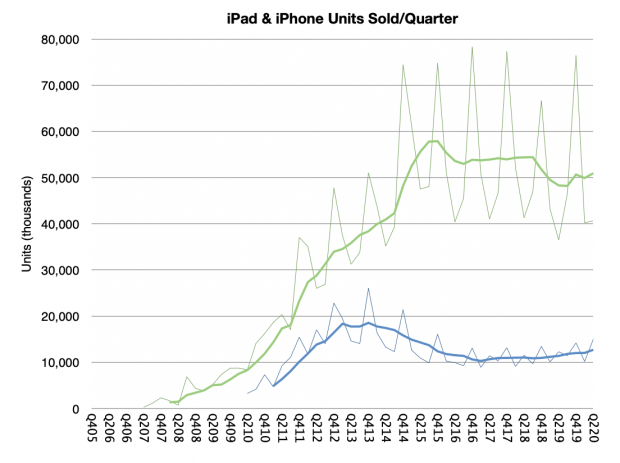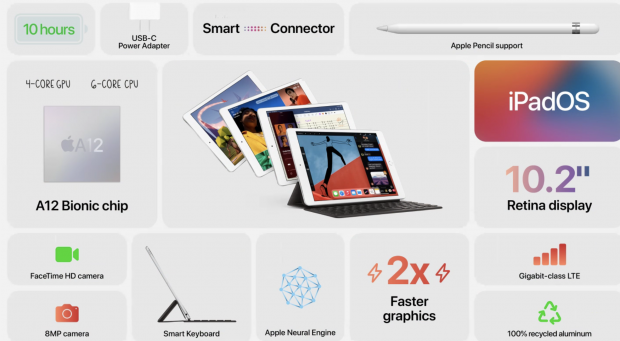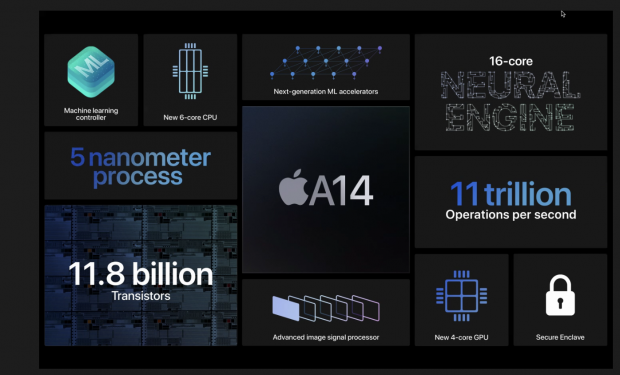The iPad was launched in April 2010, about three years after the iPhone. Followers of the company will know however that the iPad was designed first, starting sometime in the early 2000s.
The iPad was the prototype touch device because it’s less constrained but also because Apple was, at its heart, a computer company and the iPad was a computer first, device second.
Concepts of tablets predated Apple’s entry and go back to the 1990s. The idea of a “Tablet Computer” was envisioned by Alan Kay as the Dynabook as early as 1968. He famously remarked that if Apple were to build a tablet-sized iPhone it would “rule the world“.
But has the iPad come to rule the world?
Ten years is not a long time—the Mac is now 36 and it’s still kicking, Windows is only 25 years old—but already 500 million iPads have been sold.
The sales history of the iPad in units is shown below in blue vs. the iPhone in green. (Note, values in last 8 quarters are estimated).

The story that did not pan out for the iPad is that the unit growth did not match that of the iPhone, which, in its first decade sold 1.2 billion units.
But that is because the iPhone and iPad differ in significant ways. Ways which were difficult to anticipate early on.
Difficult because internally the two are basically the same. Both share the same processors and architecture and (until recently) the operating system and user interaction model. They have a similar “bill of materials” (though prices are quite different, with iPhones typically more expensive.)
The main difference has been in the display size. As I noted early on, a few inches of display may not look like a big difference but it is qualitatively very different—as much as a bathtub and a swimming pool both contain water, the quantity of water changes dramatically what you can do with either.
As a result of its size, the iPad is more likely to remain at home; not stationary in one spot, but not “in-hand” at all times. That affects how long it lasts and the tasks it’s assigned to do.
As a result, iPads stay in use longer, get passed on to new users and serve for many years. Their average life span is likely well over 4 years and 9 year old iPads are not uncommon. It’s therefore very likely that the vast majority of all iPads sold are still in use.
So the true measure of success is not units sold but number of active (and satisfied) users. The iPad user base is probably around 400 million (about 27% of total active Apple devices.) The degree of activity is also telling and is reflected in the million apps built specifically for the platform.
400 million users makes for a healthy ecosystem, especially as the users tend to be willing to spend on apps and services, which in turn, attracts more investment from developers, which leads to more usage, and so on, in a virtuous cycle.
As with all aspects of Apple analysis, the qualitative is just as important as the quantitative, even more so. The quality of the users, the usage and the product is the pre-eminent assessment.
iPad users, usage and product make for a remarkable combination. On the product side, the Fall 2020 line-up is another leap forward. In particular, the price points, breadth of offering, accessories (mini, Air, Pro, pencil, Smart Keyboard, etc.) and the power across the board.
This year sees a performance jump in the middle of the line-up with the usual mind-boggling measurements (some beginning with “nano,” and others with “tera”.)


So where to for iPad now? What worlds remain for it to conquer? So far has found users in the three “E”s: Enterprise, Education and Entertainment. Pro usage is a niche that is growing in production, especially media. What many might say is that it needs to aim at replacing the laptop, or the PC in general.
It has not done that so far, much to the delight of naysayers. But this is not as big a failure as it might seem.
First note that the Mac user base itself is not nearly as big (110 million +/-10%). iPad could be 4x bigger in user base. The Windows base is larger at 1.2 to 1.4 billion but that resists frontal assault as it is deeply entrenched around enterprise workflows. It’s also bereft of profit.
What iPad did do is create its own demand. It sits comfortably aside other platforms not in place of them. Most iPad users also have an iPhone and a PC or a Mac. I happen to have all those and more than one iPad. The iPad did something grander than kick the PC off its perch. It sat next to it and found life quite comfortable.
Discover more from Asymco
Subscribe to get the latest posts sent to your email.
